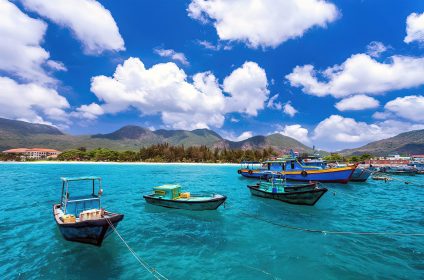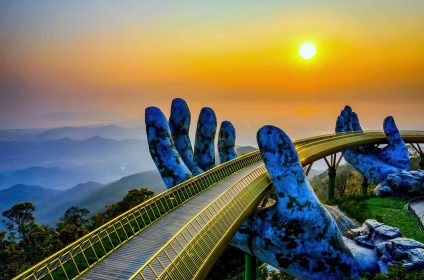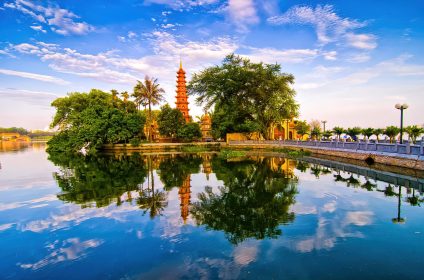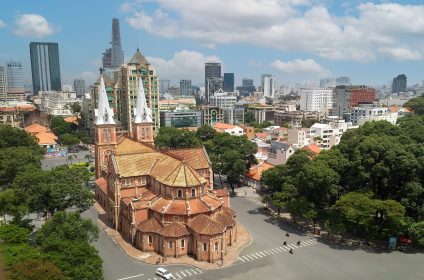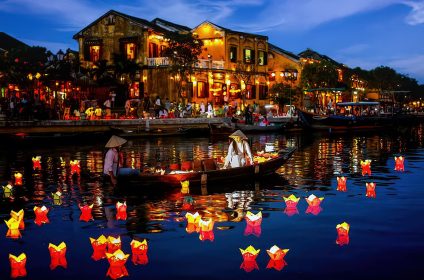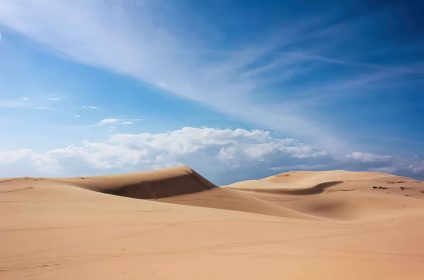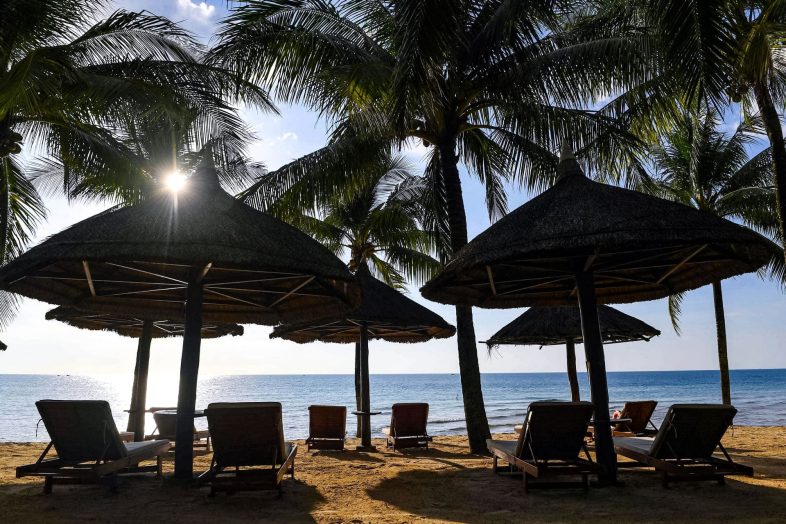
Phu Quoc
Phú Quốc is the biggest island in Vietnam. As Phú Quốc City, the island has a total area of 574 km2 (222 sq mi) and a permanent population of about 179,480. The island city of Phú Quốc, located in the Gulf of Thailand, consists of the main island and 21 smaller islands. Dương Đông ward is located on the west coast and is the island’s administrative and biggest city. The other ward on the island is An Thới, located in the south.
Its principal sectors consist of fishing, agriculture, and a rapidly expanding tourist industry. Phú Quốc has had rapid economic expansion because to the present tourism boom. Numerous infrastructural projects, including a number of five-star hotels and resorts, have been completed. Phú Quốc Foreign Airport is the primary connection between Phú Quốc and the Vietnamese mainland and other international locations.
Since March 2014, Vietnam has let all foreign tourists to visit Phú Quốc visa-free for up to thirty days. By 2017, the Vietnamese government intended to establish a Special Administrative Region on Phú Quốc Island and its surrounding islands and elevate it to the status of a provincial city with special governance.
Here stood the famous Phú Quốc Prison, which was constructed by French colonialists to hold captured Viet Cong and North Vietnamese soldiers.
Phu Quoc Island, located off the coast of Cambodia, is one of Vietnam’s most alluring tourist destinations. It possesses innumerable unspoilt beaches for water sports, gorgeous sunsets for Instagram, deserted isolated islands for exploring, and lush tropical woods for adventures.
Beyond the snow-white beaches with ice-cream-soft sand, Phu Quoc offers an extensive selection of luxury resorts, stylish eateries, and soothing spa treatments. Traditional towns, ancient temples and pagodas, and expansive green parks may also satisfy the most discerning of tourists.
Phú Quốc is a 1320 km2 island that is extremely hilly and thickly wooded; it is 48 km long from south to north and has a population of around 103,000. (2012). Located on the Gulf of Thailand 45 kilometers west of Ha Tien on the Vietnamese peninsula and 15 kilometers south of the Cambodian coast, Phú Quốc is surrounded by some of Vietnam’s most beautiful beaches and boasts the greatest seafood in the country. From the 1760s through the 1780s, French missionary Pigneau de Behaine used Phú Quốc Island as a base, and he gave refuge for Prince Nguyen Anh (later Emperor Gia Long) when he was being pursued by the Tay Son Dynasty. During the Vietnam War, there was minimal action on this island, but it was utilized as a jail for captured Viet Cong by the Republic of Vietnam Armed Forces.
Due to its soil quality and difficult topography, Phú Quốc is not a part of the Mekong delta and does not share the delta’s amazing capacity to grow rice and fruit. It is, however, the home of the greatest Fish sauce (nuoc mam) in the world, as well as a famous producer of premium pepper and delicious fish. Another attraction on Phú Quốc is the island’s native dog, which was once a wild animal and was subsequently domesticated by locals as a hunting dog. Nowadays, they are quite tamed, and it is rare to walk anywhere on the island without seeing one! These animals have extraordinarily keen teeth (since they rip their food rather than bite it) and claws that have been honed for grabbing prey over many years and are razor sharp.
Phú Quốc is still what Phuket would be if development hadn’t overwhelmed it. ABC News named Phú Quốc island and its beaches “The Cleanest and Most Beautiful Beach in the World” as of the end of February 2008; however, this is no longer the case. Phú Quốc has a significant residential garbage problem; every beach is covered with plastic rubbish from the island and tourist vessels. Only those beaches maintained regularly by hotel personnel are clean. Extensive plans for the development of Phú Quốc are being carried out, including the construction of high-rise residential areas, a number of new towns and suburbs, a socialist-style holiday resort covering a large stretch of former forest in the island’s northwest, and the total reconstruction of Dương Đông’s city center.
In April 2016, a large portion of the island’s northern region was a building site, with multiple camps of workers. The new international airport south of Dương Đông has replaced the smaller domestic airport at Phú Quốc, which was located to the north. The primary north-south route between Bai Thom and An Thoi is being improved to a 2+2 lane highway, and a new paved road from Dương Đông to Ganh Dau is complete. In the north, a golf course as well as a casino are planned. A ferry connection to Sihanoukville, Cambodia, remains a pipe dream.
Tourism In Phu Quoc
The biggest island in Vietnam, located in the Gulf of Siam, is a well-known beach resort and ecotourism destination. Phu Quoc is renowned for its natural landmarks and breathtaking coastline, which attract tens of thousands of tourists. Despite its prominence and well-developed infrastructure, Phu Quoc’s ambiance is quite tranquil and pleasant.
The island is a wonderful option for scuba diving and beach enthusiasts, as well as those who enjoy exploration and adventurous tourism. As stated above, the majority of Phu Quoc’s trip attractions are natural features. The island contains 99 mountains, with Chua being the largest. It’s just 603 meters tall and quite accessible, thus climbing Chua is a favorite tourist activity.
The Phu Quoc National Park in the island’s northern region is yet another famous trekking location. It was established in 1986 and has over 150 animal species and hundreds of plant varieties. On a daily basis, the park offers exciting and instructive trips, although during the rainy season it is closed to the public.
In addition to its gorgeous mountains and dense tropical woods, the island is famous for its waterfalls, especially the magnificent Suoi Tranh. This waterfall is situated in a scenic region, and travelers frequently visit adjacent Duong Dong Lake en route. This freshwater lake is the largest on the island, and it is located near a colorful community with the same name.
Phu Quoc is informally known as “Pearl Island” because to two farms that specialize in pearl production. It is widely considered as the best pearl factory in Vietnam, and despite its premium costs, it draws a large number of consumers. Both farms are available to the public and feature both opulent jewelry boutiques and intriguing museums.
Also of significance is the renowned Nouc Mam fish sauce plant. This odd location is quite popular with tourists, and its products are renowned worldwide and highly regarded by expert chefs. Another culinary item is the plant that produces black pepper, which also hosts tourist trips. Everyone can learn and sample common spice making techniques.
Coi Nguon Museum is Phu Quoc’s most well-known and intriguing cultural institution. It comprises a vast six-story structure and has a magnificent collection dedicated to the island’s history and culture. A few examples of museum displays include irreplaceable archeological artifacts, antique photographs, collections of pottery, historical papers, and the remains of extinct marine animals. It will take days to see all of Phu Quoc’s attractions.
The stunning beaches on Ph Quc Island have been recognized as some of the most beautiful in the world. In addition, this island’s beaches have received numerous major prizes for their exceptional ecological indicators. Long Beach is the island’s most renowned coastline. This beach is maintained and cleaned throughout the year. As Long Beach’s infrastructure improves with each passing season, it currently offers everything necessary for a comfortable stay. There are a number of hotels and restaurants nearby, however travellers should be aware that this area may become rather congested during high season.
One of the primary downsides of Long Beach is its steep bottom. The water is already 2 meters deep barely 10 meters from the coast, therefore this beach is not ideal for families with young children. In general, families choose Ong Lang Beach. In close proximity to the coast, the water is shallow and clean. Numerous palm trees are located close to the ocean, so holidaymakers can always find shade at Ong Lang, even during the hottest part of the day. Bai Dai Beach is widely regarded as one of the world’s most beautiful beaches. Despite its prominent status and prominence, this location is very tranquil.
Summer Vacation on Phu Quoc
Phu Quoc’s largest and most popular beach is Long Beach. It is equally popular among locals and tourists alike. The lovely sandy beach has several prominent hotels, restaurants, and entertainment spots nearby. The occupation of Long Beach is constant. For those who value comfort, the resort has excellent equipment and rental services to offer. Given that the beach stretches for almost 7 kilometers, it is not difficult to find a suitable area to settle down.
Sao Beach can be considered as Phu Quoc’s biggest competitor in terms of size. As one of the beautiful beaches on the island, it consists of pure white sand and symmetrical palm trees on either side. But this rather than a disadvantage because there are no amenities or entertainment in Sao Beach . This is an ideal place for people who appreciate peace and seclusion during vacationing time. Some interesting hotels are also located along the beach.
Ong Lang Beach in the western part of the region boasts a number of well-known resorts around it (with ‘it’ referring to Ong Lang). The beach is more peaceful compared to Phu Quoc’s major one despite being luxurious. Early morning until late at night will offer various means of leisure like souvenirs for shopping enthusiasts as well as entertainments options for visitors enjoying their time at the shore located next to Ong Lang throughout daylong. Therefore those who prefer luxury living conditions should take into account such destinations as Ong Lang.
Dai Beach in north west direction on this island is suitable for all kinds of tourists without exception. The central part of the beach offers enough features while attracting many tourists as well. There are numerous scenic places within few minutes from coastal areas where people loving wilderness would have fun too You know that this sandy beach also has lush tropical vegetation with coconut plantations surrounding it making scenery even more attractive right?
An Thoi’s small harbor may appeal to travelers searching for something exotic or unusual on this island. The town does not have a beach however there are several boats and cutters that take daily tours of nearby tiny islands. It is a great place for those who love trekking or simply prefer spending time in nature, without being disturbed by people. Another beautiful example of the beach is Bai Ganh Dau which is located far from overcrowded tourist places in Phu Quoc hence it is appropriate for visitors enjoying their solitude either on their own or during solitary holidays. Moreover, it is quite silent and clean making it attractive to families.
Bai Cua Can Beach offers one of the most amazing views of the entire area around. You can enjoy sunbathing here or walk around during sunset hours at this spot. Numerous scuba divers frequent Bai Vung Bau beach due to its many diving schools. This also avails an opportunity to make a trip across some of the most splendid diving areas along the coastline too.
Geography
Phú Quốc is located south of the Cambodian coast, south of Kampot, and 40 kilometers (22 nautical miles) west of Hà Tiên, the closest Vietnamese coastal city. The island is approximately 50 kilometers (31 miles) from north to south and 25 kilometers (16 miles) from east to west at its widest point. It is also 17 nautical miles (31 kilometers) from Kampot, 62 nautical miles (115 kilometers) from Rạch Giá, and approximately 290 nautical miles (540 kilometers) from Laem Chaem, Thailand. A rocky ridge called as “99 Peaks” traverses the length of Phú Quốc, with Chúa Mountain at 603 meters (1,978 feet) being the highest.
Phú Quốc Island is mainly composed of sedimentary rocks from the Mesozoic and Cenozoic age, including heterogeneous conglomerate composition, layering thick, quartz pebbles, silica, limestone, rhyolite and felsite. The Mesozoic rocks are classified in Phú Quốc Formation (K pq). The Cenozoic sediments are classified in formations of Long Toàn (middle – upper Pleistocene), Long Mỹ (upper Pleistocene), Hậu Giang (lower – middle Holocene), upper Holocene sediments, and undivided Quaternary (Q).
Climate
The island has a monsoonal sub-equatorial climate where there are two distinct seasons: wet season from April to November and dry season from December to March. Even during the dry months there is precipitation as with this climatic category. For instance, the mean annual rainfall is 3,029mm (9.93 ft). In the north highlands, it may rain up to 4,000mm (13ft) in some years. The warmest months are April and May when temperatures can reach up to 35°C (95°F).
In November-March period, the average maximum temperature per day is approximately thirty one degrees Celsius while that of the lowest temperature overnight (before dawn) hovers around 23 degrees Celsius. Maybe early morning with few stray high clouds which are dissipating by mid-morning; this time bears the least humidity throughout the year.
During April to June and again in late October, temperatures remain slightly higher compared to peak season with relative humidities ranging between 80-85%. Fewer tourists come at this time of year and weather usually tends to be cool.

Phu Quoc - Info
Country
Calling code
Population
Area
Official language
Time zone
Phu Quoc Travel Guide
How To Travel To Phu Quoc
Visitors from any other country except Australia and the United States traveling to Phú Quốc via cruise ships or connecting airlines are no longer required to have a visa for up to 30 days.
If coming by flight, a traveler must have a same-day connecting flight from Hanoi or Ho Chi Minh City to Phú Quốc, stay in a transit area, and go through immigration at Phú Quốc so as not to be able to get an exemption of visa.
17 flights operate between Phu Quoc International Airport and Ho Chi Minh City (Saigon) daily, Vietnam Airlines, Pacific Airlines (tickets purchased through Vietnam Airlines), VietJet Air, and Bamboo Airways. These can be quite cheap (as low as US$33 one way). Domestic flights fly between Hanoi, Haiphong, Vinh, Da Nang, Nha Trang and Can Tho while international flights serve Bangkok (Thai Vietjet Air), Seoul and Mumbai (VietJet Air), Kuala Lumpur (AirAsia).
How To Travel Around Phu Quoc
One thing that makes it beneficial to settle at these first class Long Beach lodgings is the fact that everything is so easily accessible. If you choose Mai House or Tropicana as your base, you may simply walk to everywhere and have a three- or four-day vacation of doing nothing in particular. Should you camp out at La Veranda, you might not come back.
A circular bus route with fifteen stops on air-conditioned hop-on, hop-off buses that go around the island. From Ding Dong Night Market eastwards through the centre of Long Beach to An Hoi for a cable car service every 40 minutes starting from 08:00 and finishing at 19:00 daily. For sale on bus, online services, hotels and travel agencies: A ticket for six hours costs VND140000 while a twenty-four-hour ticket also costs VND220000). Observe for big yellow bus stop signs.
Route 11 has service every half an hour from Dương Đông down Long Beach to An Thoi. There are flights to the airport too. Costs range between 20 000-30 000 dong.
Beaches in Phu Quoc
The island of Phu Quoc looks like an idyllic colonial outpost with its beautiful sandy beaches and the dense vegetation in the interior. It has more than 150 kilometers of coastline making it endowed with many fantastic beaches to discover for holidaymakers.
Long Beach is the only one in Vietnam that allows visitors to view the sun as it sets while other beaches in the country face east. This beach, which has its name indicates is located on the western side of the Island. Sao Beach (Bãi Sao) is one of Phu Quoc’s most beautiful tropical sandy beaches. It can be found along An Thoi town’s coast; 25 kms away from downtown.
On the southern coast of Phu Quoc island lies Khem beach (or Bai Khem in Vietnamese). People come to Khem Beach because of its tranquil shores, long white sand stretches, and calm waves. In particular summer sees many tourists being attracted there due to its beauty.
Attractions & Things To See
Other activities that can be done on Phu Quoc are tourist attractions and experiences. And if you want to experience what local life is all about, then this place is the perfect destination for you. It has got everything from Cao Dai and Buddhist temples to vibrant markets, old-fashioned fishing villages and even pepper plantations.
Over 50% of this tropical island still remains a UNESCO listed national park where one can spend an entire day spotting rare wildlife species, hiking, camping, photographing and bird watching. Despite the long beaches full of accommodation options and modern facilities available here.
More than half of Phu Quoc Island is part of Phu Quoc National Park, which gives nature lovers an opportunity to observe rare fauna like long-tailed macaques, silver langurs, otters or hornbills.
Activities & Things to do
Apart from lying on its lovely beaches, Phu Quoc has many other things to see including Buddhist shrines, historical sites, the national park and fishing villages. However, despite modern facilities such as superior hotels and resorts that have come up in the area as well as foreign eateries one can still engage in various sight-seeing tours when traveling.
Phu Quoc is a good place for diving because it is cheap and full of diverse marine life. Those interested in joining must go to the dive shop which has been issuing global certifications for fifteen years. On the north side of the island beginners should dive since it is not very deep there and many corals are visible in a beautiful setting. In addition, there are many locations in the south that offer great diving conditions for experienced divers with depths reaching 40 meters.
Those fond of diving and snorkeling are welcome to Turtle Island where they could spot more than one hundred species of tropical fishes.
Food & Restaurants in Phu Quoc
Guests who dine at the On the Rocks Restaurant of Mango Bay Resort can choose from a wide range of authentic Vietnamese, Asian and western foods at any time of day, while they look out on Ong Lang Beach. The Phu Quoc Mackerel should not be missed which incorporates locally caught mackerel that is poached in soybean and shiitake mushroom broth.
At an affordable rate, Khanh Ly Vegetarian Restaurant features a large buffet with vegetables, soups, noodles and imitation meat dishes. Found in Duong Dong this self-service eatery mostly serves residents or tourists wishing to have vegetarian meals on Phu Quoc Island during their holiday.
The Pepper Tree sits atop an all-white terrace overlooking La Veranda Resort Phu Quoc – MGallery’s beach and garden. It is here where rich visitors may sample first-rate wines as well as chefs’ award-winning gourmet cuisine.
Shopping in Phu Quoc
Phu Quoc Island’s street markets are among the best places to shop because they offer a wide range of handicrafts, local foodstuffs, and fresh produce. The local markets which are open every day also serve as great places where to get genuine Vietnamese dishes and sea food that is fairly priced. Most of the nice stores and neighborhood supermarkets on Phu Quoc Island can be located at Duong Dong Market and Long Beach.
If you want to go shopping, remember that haggling is not a usual thing in Phu Quoc as it is in other parts of Vietnam. This implies that you can easily get what you need for cheaper from another seller who doesn’t change his/her prices often unlike them. This indicates that there are no standard pricing rules available because for example the price for the same item might differ greatly between two neighboring firms. Also keep in mind that there doesn’t appear to be a wholesale discount here.
Nightlife in Phu Quoc
Phu Quoc Island’s greatest nightlife presents a host of fun-loving residents, expats and tourists eager to have a good time while on vacation.
Though Phu Quoc’s nightlife is relatively mild compared to other towns in the Vietnamese mainland, it has Beach-side pubs, wine lounges, late-night eating places and lively nightclubs. These joints that are more casual in nature are famous for their great service, attractive décor, strong cocktails, unusual spirits and delicious foods at reasonable prices.
Duong Dong also has a night market where people can eat traditional Vietnamese delicacies and shop for small things until midnight. Arranging bonfires, dance performances, full moon parties, sporting activities as well as visiting DJs from Europe or Vietnam all add up to Dung Hoang’s vibrant nightlife.
In Dung Hoang there are many bars along the main street with basically similar beer selection.
Stay Safe & Healthy in Phu Quoc
The most dangerous thing for you while in Phu Quoc is not illness but road accident.
Remember to take along hotel information and a simple first aid kit before you go on a motorbike holiday.
Most hotels distribute mySherpa maps to their guests which show the emergency phone numbers of the police, ambulance and hospitals, as well as giving advice on actions that must be taken during an emergency. Always bring these telephone contacts with you.
Dng ông hospital should be avoided if at all possible. The following modern hospital is located Rach Gia.
Find out how long it will take to get there in case of an emergency accident before setting off. The main problem is the language barrier.

